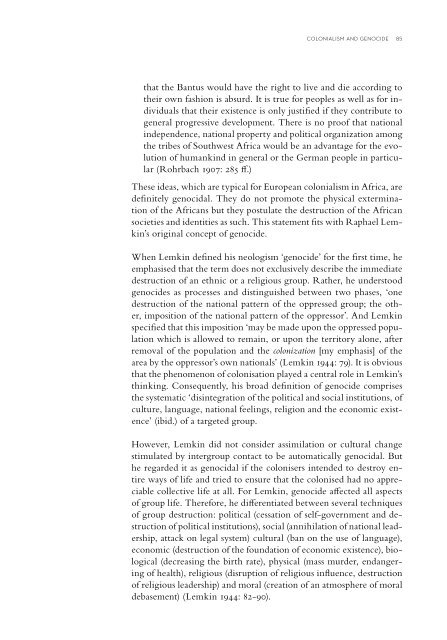60 years after the UN Convention - Dag Hammarskjöld Foundation
60 years after the UN Convention - Dag Hammarskjöld Foundation
60 years after the UN Convention - Dag Hammarskjöld Foundation
You also want an ePaper? Increase the reach of your titles
YUMPU automatically turns print PDFs into web optimized ePapers that Google loves.
colonialism and genocide 85<br />
that <strong>the</strong> Bantus would have <strong>the</strong> right to live and die according to<br />
<strong>the</strong>ir own fashion is absurd. It is true for peoples as well as for individuals<br />
that <strong>the</strong>ir existence is only justifi ed if <strong>the</strong>y contribute to<br />
general progressive development. There is no proof that national<br />
independence, national property and political organization among<br />
<strong>the</strong> tribes of Southwest Africa would be an advantage for <strong>the</strong> evolution<br />
of humankind in general or <strong>the</strong> German people in particular<br />
(Rohrbach 1907: 285 ff .)<br />
These ideas, which are typical for European colonialism in Africa, are<br />
defi nitely genocidal. They do not promote <strong>the</strong> physical extermination<br />
of <strong>the</strong> Africans but <strong>the</strong>y postulate <strong>the</strong> destruction of <strong>the</strong> African<br />
societies and identities as such. This statement fi ts with Raphael Lemkin’s<br />
original concept of genocide.<br />
When Lemkin defi ned his neologism ‘genocide’ for <strong>the</strong> fi rst time, he<br />
emphasised that <strong>the</strong> term does not exclusively describe <strong>the</strong> immediate<br />
destruction of an ethnic or a religious group. Ra<strong>the</strong>r, he understood<br />
genocides as processes and distinguished between two phases, ‘one<br />
destruction of <strong>the</strong> national pattern of <strong>the</strong> oppressed group; <strong>the</strong> o<strong>the</strong>r,<br />
imposition of <strong>the</strong> national pattern of <strong>the</strong> oppressor’. And Lemkin<br />
specifi ed that this imposition ‘may be made upon <strong>the</strong> oppressed population<br />
which is allowed to remain, or upon <strong>the</strong> territory alone, <strong>after</strong><br />
removal of <strong>the</strong> population and <strong>the</strong> colonization [my emphasis] of <strong>the</strong><br />
area by <strong>the</strong> oppressor’s own nationals’ (Lemkin 1944: 79). It is obvious<br />
that <strong>the</strong> phenomenon of colonisation played a central role in Lemkin’s<br />
thinking. Consequently, his broad defi nition of genocide comprises<br />
<strong>the</strong> systematic ‘disintegration of <strong>the</strong> political and social institutions, of<br />
culture, language, national feelings, religion and <strong>the</strong> economic existence’<br />
(ibid.) of a targeted group.<br />
However, Lemkin did not consider assimilation or cultural change<br />
stimulated by intergroup contact to be automatically genocidal. But<br />
he regarded it as genocidal if <strong>the</strong> colonisers intended to destroy entire<br />
ways of life and tried to ensure that <strong>the</strong> colonised had no appreciable<br />
collective life at all. For Lemkin, genocide aff ected all aspects<br />
of group life. Therefore, he diff erentiated between several techniques<br />
of group destruction: political (cessation of self-government and destruction<br />
of political institutions), social (annihilation of national leadership,<br />
attack on legal system) cultural (ban on <strong>the</strong> use of language),<br />
economic (destruction of <strong>the</strong> foundation of economic existence), biological<br />
(decreasing <strong>the</strong> birth rate), physical (mass murder, endangering<br />
of health), religious (disruption of religious infl uence, destruction<br />
of religious leadership) and moral (creation of an atmosphere of moral<br />
debasement) (Lemkin 1944: 82-90).

















